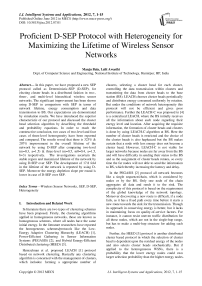Proficient D-SEP Protocol with Heterogeneity for Maximizing the Lifetime of Wireless Sensor Networks
Автор: Manju Bala, Lalit Awasthi
Журнал: International Journal of Intelligent Systems and Applications(IJISA) @ijisa
Статья в выпуске: 7 vol.4, 2012 года.
Бесплатный доступ
In this paper, we have proposed a new SEP protocol called as Deterministic-SEP (D-SEP), for electing cluster heads in a distributed fashion in two-, three-, and multi-level hierarchical wireless sensor networks. The significant improvement has been shown using D-SEP in comparison with SEP in terms of network lifetime, energy consumption and data transmission to BS. Our expectations are demonstrated by simulation results. We have introduced the superior characteristic of our protocol and discussed the cluster head selection algorithm by describing the threshold and probability equations. In order to reach the constructive conclusion, two cases of two-level and four cases of three-level heterogeneity have been reported and compared. The results reveal that there is 323% & 207% improvement in the overall lifetime of the network by using D-SEP after comparing two-level (m=0.3, a=1.5) & three-level (m=0.5, m0=0.4, a=1.5, b=3) respectively. The investigations ascertain the stable region and maximized lifetime of the network by using D-SEP over SEP. The development of 17.8 fold in the lifetime of the network is reported by using D-SEP. Moreover the energy depletion slope per round is lower in case of D-SEP over SEP.
Wireless Sensor Networks, SEP, D-SEP, Heterogeneity
Короткий адрес: https://sciup.org/15010274
IDR: 15010274
Текст научной статьи Proficient D-SEP Protocol with Heterogeneity for Maximizing the Lifetime of Wireless Sensor Networks
Published Online June 2012 in MECS DOI: 10.5815/ijisa.2012.07.01
-
I. Introduction and Related Work
In literature there are two types of clustering schemes have been proposed. Firstly, the clustering algorithms applied in homogeneous networks, those are known as homogeneous schemes, where all nodes have the same initial energy. In the literature researchers have reported the homogeneous schemes/protocols like the Low-Energy Adaptive Clustering Hierarchy (LEACH) [1], Power-Efficient Gathering in Sensor Information Systems (PEGASIS) [2], and Hybrid Energy-Efficient Distributed clustering (HEED) [3].
Heinzelman et al. proposed LEACH [1] protocol based on network clustering. Basically any clustering algorithm is concerned with the management of clusters, which includes: forming a appropriate number of clusters, selecting a cluster head for each cluster, controlling the data transmission within clusters and transmitting the data from cluster heads to the base station (BS). LEACH chooses cluster heads periodically and distributes energy consumed uniformly by rotation. But under the conditions of network heterogeneity this protocol will not be efficient and gives poor performance. Further the LEACH-C was proposed in [4] is a centralized LEACH, where the BS initially receives all the information about each node regarding their energy level and location. After acquiring the requisite information, the formation of cluster heads and clusters is done by using LEACH-C algorithm at BS. Here the number of cluster heads is restricted and the choice of the cluster heads is also haphazard but the BS makes certain that a node with less energy does not become a cluster head. However, LEACH-C is not viable for larger networks because nodes are far away from the BS and will have difficulty in sending their status to the BS and as the assignment of cluster heads rotates, so every time the far nodes will not able to send the information to BS, which thereby increasing the latency and delay.
In the PEGASIS [2] protocol all network becomes like a single sequence/chain, which is considered by nodes or by the BS. Only one node of the chain aggregates all data and sends it to the sink. The complexity of this protocol is based on the requirement of the global knowledge of the network topology. Moreover discovering a new route is difficult, if a node fails, as it has a fixed path every time before it starts a new route towards the sink for the transmission. Though its approach in conserving energy is better, but it lacks in maintaining focus on quality-of-service factors. For instance, it cannot resist uneven traffic distribution for all those nodes, which are not in the single-hop range, but has to make a multi-hop structure for adding such nodes.
Further, the HEED [3] protocol is another distributed cluster based protocol in which the selection of cluster head is dependent upon the residual energy of the nodes and also selects cluster heads stochastically. But if applied to the heterogeneous WSNs, there is a probability that the lower energy nodes could own larger selection probability than the higher energy nodes.
SEP [5] is a proposed scheme for heterogeneous wireless sensor networks. Here two types of nodes (Advanced and normal nodes) are considered with different initial energy. The advanced nodes are equipped with more energy than the normal nodes at the beginning. Further, in literature it has been observed that the SEP yields longer stability region for higher values of extra energy brought by more powerful nodes, but it cannot be applied to multi-level heterogeneous WSNs.
M. Ye et al., [7], develop the EECS which chooses the cluster- heads with more residual energy through local radio communication. In cluster formation phase, EECS considers the trade-off of energy expenditure between nodes to the cluster-heads and the cluster heads to the BS. But on the other hand, it increases the requirement of global knowledge about the distances between the cluster heads and the BS.
Moreover, in [9], Li Qing et al propose and validate the DEEC protocol, which uses a new conception based on the ratio between residual energy of each node and the average energy of the network. The epochs of being cluster-heads for nodes are different according to their initial and residual energy. The nodes with high initial and residual energy will have more chances to become the cluster-heads than the nodes with low energy.
In the EDEEC B. elbhiri et al,[10] developed a clustering algorithm for heterogeneous network, using an intermediate cluster-based hierarchical solution. However, this protocol is suitable only if the BS is far away from the network. Further, SBDEEC[11] protocol was based on DEEC but with new proposal strategies. The SBDEEC is a Stochastic and balanced DEEC. It is stochastic because the number of transmission intraclusters is reduced when the objective is to collect the maximum or minimum data values in a region and balanced because the clustering is more fair and equitable.
As mentioned in [5] the SEP improves the stable region of the clustering hierarchy process using the characteristic parameters of heterogeneity in terms of different initial energy of nodes. In order to prolong the stable region, SEP attempts to maintain the constraint of well balanced energy consumption. Intuitively, advanced nodes have to become cluster heads more often than the normal nodes, which is equivalent to a fairness constraint on energy consumption. Keeping in view the heterogeneity even SEP extends the battery life time, but it cannot be applied to multi-level heterogeneous WSNs. Here in this paper we have extended the work for three- and multi-level heterogeneity and proposed the new SEP protocol named as Deterministic Stable Election Protocol (D-SEP) with modified threshold equation to determine the weighted probabilities to elect the cluster head.
The paper is organized as follows. The introduction is explained in section I and thereafter the operation of D-SEP is described in section II. Further the results are discussed in section III and the concluding remarks are reported in section IV.
-
II. Proposed Deterministic stable Election Protocol
(D-SEP)
We present an enhanced SEP algorithm for WSNs in the presence of energy heterogeneity. Using a heterogeneous three-tier node setting in a clustering algorithmic approach, nodes elect themselves as cluster heads based on their energy levels, retaining more uniformly distributed energy among sensor nodes. Our result shows that the modified SEP named as D-SEP is more robust with respect to network life time and resource sharing.
D-SEP protocol goal is to increase the lifetime and stability of the network in the presence of heterogeneous nodes. Since cluster heads consume more energy than cluster members in receiving and sensing data from their member nodes, performing signal processing and sending the aggregated data to next node or base station, the role of cluster head must be rotated among sensor nodes. Therefore, D-SEP works in rounds as SEP and also considers how to optimally select the cluster heads in the heterogonous network. Traditionally as per SEP, Cluster head algorithm is broken into rounds. At each round node decides whether to become a cluster head based on threshold calculated by the suggested percentage of cluster heads for the network (determined a priori) and the number of times the node has been a cluster-head so far. This decision is made by the nodes by choosing the random number between 0 and 1. If the number is less than a threshold T(si) the node becomes a cluster-head for the current round. In the proposed D-SEP the threshold is modified and set as:
^(St) = 7 у —у х [Eres ,дuai + (rsd iv —) x
-
1 - (p ;x(r mo d—)) p 1 (1 - Eres Muai)] (1)
Where threshold is set differently and dependent on pi that has been set according to two-, three- and multilevel heterogeneity as mentioned below and rest of the parameters are same as defined in section III. Here rs is the number of consecutive rounds in which a node has not been cluster-head. When rs reaches the value 1/pi the threshold T(Si) is reset to the value, it had before the inclusion of the remaining energy into the threshold- equation mentioned in section II. Thus, the chance of node n to become cluster head increases because of a high threshold. A possible blockade of the network is solved. Additionally, rs is reset to 0 when a node becomes cluster head. Thus, we ensure that data is transmitted to the base station as long as nodes are alive. For the purpose of this study, we use similar radio communication and consumption model as reported in [12].
In real heterogeneous application scenes, though some nodes may have more residual energy than others, because of the computational heterogeneity, these nodes may die or consume much more energy than others in the next round cluster head operation. Considering the energy dissipation in sequent rounds is correlative, D-SEP uses different average energy consumption of two types of cluster heads in previous round as energy consumptions in the next round to forecast the cluster heads. The more residual energy after the next round operation and larger is the probability of being elected as a cluster head. The weighed election probability for two-, three- and multi-level heterogeneity is mentioned below:
Two-level Heterogeneity
Two type of nodes known as normal and advanced nodes are considered with their different initial energy for two-level heterogeneous networks. The reference value of pi is different for these types of nodes. The probabilities of normal and advanced nodes are obtained similarly as reported in [9]:
=
{
Popt × Eresidual
( 1+am )× Eaverage Popt ×( 1+a )× Eresidual
( 1+am )× Eaverage
if St ∈ G'is tℎe normal node if st ∈ G" is tℎe advanced node
Threshold value for cluster head selection is obtained for normal and advanced nodes respectively by putting value of pi in Eq. (1) otherwise it is zero. G’ and G’’ is the set of normal and advanced nodes.
Three-level Heterogeneity
In this case three types of nodes known as normal, advanced and super nodes are considered based on fractional difference in their initial energy level. Here the reference value of pi is different for these types of nodes. The probabilities of normal, advanced and super nodes are [13-15]:
⎧ × Eresidual ______
⎧ ( .( a+mo . ))× Eaverage
Popt (1+a)× Eresidual
⎨ ( 1+m .( a+mo .Ь))× Eaverage
⎪ Popt ( 1+b )× Eresidual
⎩ ( 1+m .( a+mo . b ))× Eaverage
if st ∈ G' is tℎe normal node if si ∈ G" is tℎe advanced node if si ∈ G”'is tℎe super node
Threshold value for cluster head selection is calculated for normal, advanced, super nodes by putting above values in Eq. (1) otherwise it is zero. G’, G’’ and G’’’ is the set of normal and advanced nodes.
Multilevel Heterogeneity
In the multi-level heterogeneity all the nodes have been considered with different initial energy. The probability of a node to be a cluster head is obtained as reported in[9,13-15]:
Popt × N ×( l + CZ; )× ^residual =
( N+ ∑ 1=1 ai )× ^average
The threshold value for the cluster head selection is calculated for multi-level heterogeneous nodes by putting Eq. (4) in Eq. (1) otherwise it is zero.
The proposed D-SEP is based on the weighted probabilities as mentioned above to obtain the threshold for normal, super and advanced nodes and that is used to elect the cluster head in each round. It is also concern about the number of consecutive rounds in which a node has not been cluster-head. In this paper same strategy has been followed for estimating the energy in the network as reported in [12-15]. Since the probabilities calculated are depended on the average energy of the network at round r, hence this is to be calculated. This average energy is estimated as [14]:
E = × E x f 1 - average =× ×
Where R denotes the total rounds of the network lifetime. Hence actual energy of each node lies around E average therefore all nodes die almost at the same time. R can be defined as
R _ Etotal
Eround
E round is energy dissipated in the network in a round. Since BS is located at the centre, presumably the radio energy model follows the multipath model. So the energy dissipated by the cluster head is given by
Ech = ( I -1)+ leda^ + LEelec +
^^amp^toBS (7)
Non cluster nodes presumably follow the space free model since their distance to the cluster head is small. Hence the energy dissipated by non cluster node is [14]:
^non-CH = + LEjsdtocH
This total energy dissipated Eround is equal to per round is given by [14]
Eround = (2 NEelec + neda + ^^amp^toBS +
N E^sdt0(2H ) (9)
where k is number of clusters dtoBS is the average distance between cluster head and the base station and dtoCH is the average distance between the cluster members and the cluster head. Now dtocH = , dtoBs = 0․765
√
By calculating the derivative of E round with respect to k to zero

Popt
^opt 1
N 0.765

Hence we can find the energy dissipated per round by substituting equations 10 & 11 in 9. Due to the heterogeneity factors R is taken as 1.5 R (Since E average will be too large at the end from Eq. 5, some nodes will not die finally). The optimal probability for a node to become a cluster popt head is very important. In the literature, the authors showed that if the cluster formation is not done in an optimal way, the total consumed energy of the sensor network per round is increased exponentially either when the number of clusters that are created is greater or especially when the number of the constructed clusters is less than the optimal number of clusters.
III. Results and Discussion
In this section, we have reported the performance of WSN at all the levels of heterogeneity (two-, three- and multi-level) using D-SEP protocol in comparison with SEP using matlab. Implementation is based on the model discussed in section II. The parameters used in the simulation are mentioned below in table 1.1.
Secondly, we run simulation for our proposed protocol D-SEP to compute the number of received messages at the BS over number of rounds and compare the results of SEP and D-SEP protocols. Fig. 1(b) shows that the messages delivered by D-SEP to the BS are better than SEP, this means that D-SEP is an energy-aware adaptive clustering protocol
In case of D-SEP, 145000 packets are transmitted to the base station within same span of time, whereas this transmission is just 11000 packets in case of SEP. These results also justify the performance superiority of D-SEP over SEP. Further, in Fig. 1(c) for both SEP and D-SEP death of first nodes starts almost after 1000 rounds in both the cases but in case of SEP last node die after 2500 rounds, while for D-SEP it is after 11000 rounds that is 4.4 times higher than SEP. Fig. 1(d) shows the total remaining energy over the time i.e., number of rounds.
TABLE 1. SIMULATION PARAMETERS
|
Parameters |
Value |
|
Network Field |
(100,100) |
|
Number of nodes |
100 |
|
Eo (Initial energy of normal nodes) |
0.5 J |
|
Message Size |
4000 Bits |
|
Eelec |
50nJ/bit |
|
Efs |
10nJ/bit/m2 |
|
Eamp |
0.0013pJ/bit/m4 |
|
EDA |
5nJ/bit/signal |
|
do ( Threshold Distance) |
70m |
Two-Level Heterogeneity
Case-1: (m = 0.1 and a = 0.5)

x 10
(a)
1.5
No. of rounds
SEP
D-SEP
0.5
1.5
No. of rounds
(b)
2.5
. .4
x 104
SEP
D-SEP
2.5 x 104
D-SEP
Round Node Dies Total energy Nodes dead
100 г Г Г
20 г
0 0.5 1

1.5 2
2.5
No. of rounds 4
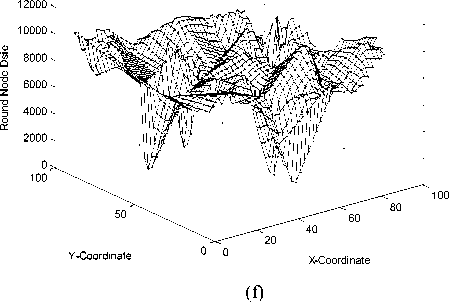
Figure 1. Comparison between SEP and D-SEP in presence of heterogenity:
(a) Alive nodes per round
(b) Total data packects transmistted to BS over rounds
(c) Nodes dead per round
(d) Total energy consumed per round
(e) Node dying distribution for SEP
(f) Node dying distribution for D-SEP
(c)
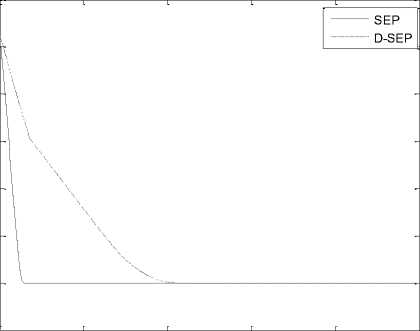
-10
0 0.5 1 1.5 2 2.5
No. of rounds 4
(d)
SEP
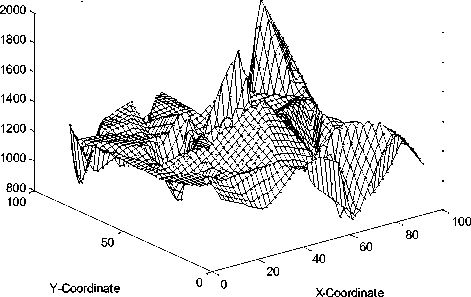
(e)
The comparison between these Figs. establish that the stabilty of cluster formation in D-SEP protocol is very high and this formation is extended upto the 110000 rounds. This happens due to the reason that the proposed D-SEP protocol is energy adaptive and optimize the cluster formation by taking the advantage of deterministic threshold level, which is dependent on residual, average energy of nodes and cosiquently cluster formation frequency increases that leads to increase the lifetime of the network.
Case-2: (m = 0.3, and a = 1.5)
For the second case of two-level heterogeneity, we have deployed 30 advanced nodes with 2.5 times more energy than normal nodes. Here in fig. 2(a), it has been shown that D-SEP proved to be better than SEP. In SEP death of first node starts after 1100 rounds while for D-SEP it is after 4000 rounds. Here, the early death of nodes is observed in case of SEP over D-SEP. The investigation reveals that the death of last node is after 5100 and 21000 rounds in case of SEP and D-SEP respectively that is 4.11 times higher than SEP.
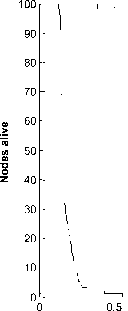
SEP
D-SEP
1 1.5 2 2.5
No. of rounds 4
(a)
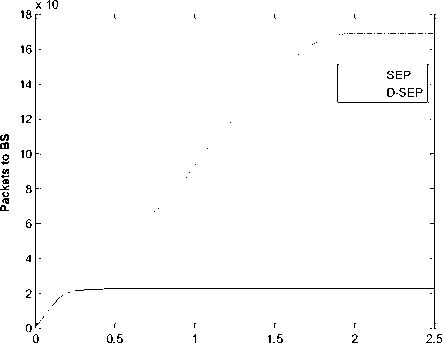
No. of rounds
4 x 104
(b)
SEP
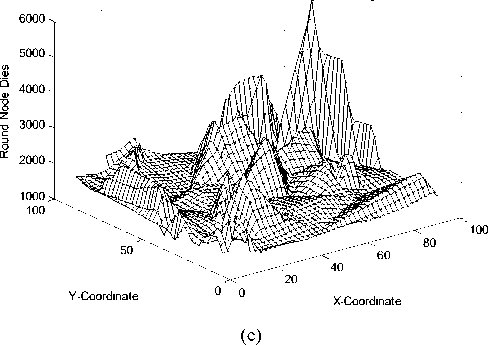

SEP
D-SEP
0.5
1 1.5
No. of rounds
(c)
2.5
x 104
D-SEP
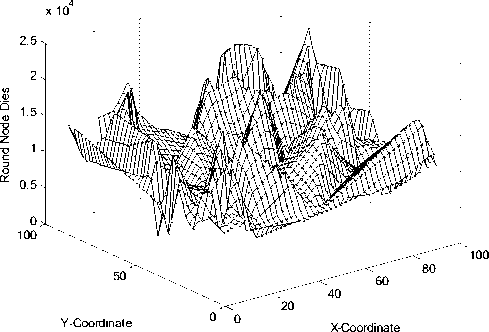
(f)
Figure 2. Comparison between SEP and D-SEP in presence of heterogenity:
(a) Alive nodes per round
(b) Total data packects transmistted to BS over rounds
(c) Nodes dead per round
(d) Total energy consumed per round
(e) Node dying distribution for SEP
(f) Node dying distribution for D-SEP
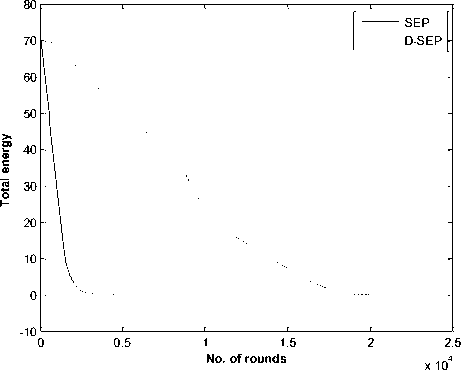
The Fig. 2(b) indicates the significant improvement in the numbers of data packets received at base station in case of D-SEP over SEP. There are 7.38 times packets are sent to the BS in case of D-SEP over SEP. Here in case of SEP the death of first node starts after 1100 rounds while for D-SEP it is after 4000 rounds as shown in fig. 2(c). Moreover, the death of last node in case of SEP is after 5100 rounds, whereas it is after 21000 rounds in case of D-SEP. Here, the results ascertain the early death of first node in case of SEP over D-SEP. These results further justify that the performance of D-SEP is superior than SEP. Fig. 2(d) shows the comparison of D-SEP and SEP for total remaining energy over time i.e., number of rounds. Here the results predict that total energy consumed is much higher in case of SEP in comparison with D-SEP.
We increase the fraction m of the advanced nodes from 0.1 to 0.3 and a from 0.5 to 1.5 that gives significant change in the performance in terms of increase in number of rounds that leads to enhance the lifetime of the network, which is 1.9 times higher in case-2.
Three-Level Heterogeneity:
Case-1: (m = 0.3, m o = 0.6, a = 0.5 and b = 1)
In three-level heterogeneity, there are 12 advanced nodes [N*m*(1-m0)] deployed with 1.5 times [E0*(1+a)] more energy than normal nodes and 18 super nodes [N*m*m 0 ] deployed with 2 times [E0*(1+b)] more energy than the normal nodes and rest are normal nodes with energy E 0 .
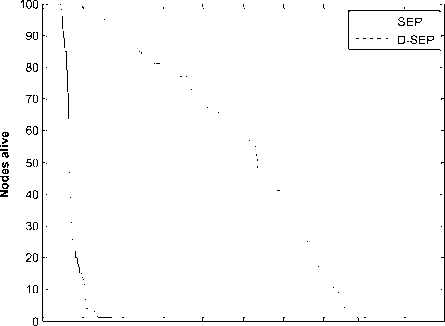
0 0.2 0.4 0.6 0.8 1 1.2 1.4 1.6 1.8 2
No. of rounds 4
(a)

SEP
D-SEP
0 LJ--—---£-----£-----£-----£-----£-----£-----£-----£----J
0 0.2 0.4 0.6 0.8 1 1.2 1.4 1.6 1.8 2
No. of rounds x 104
(c)
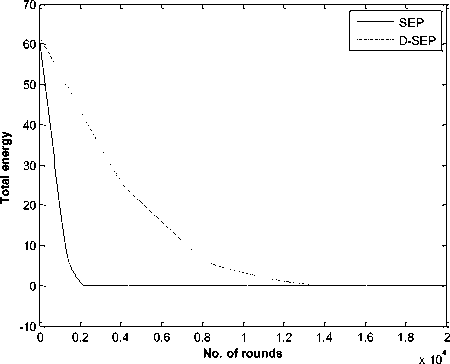
(d)
SEP
No. of rounds
x 10
(b)
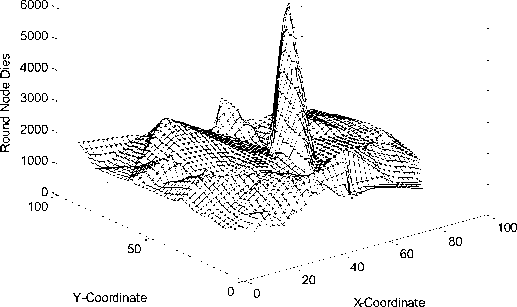
(e)
D-SEP x 104
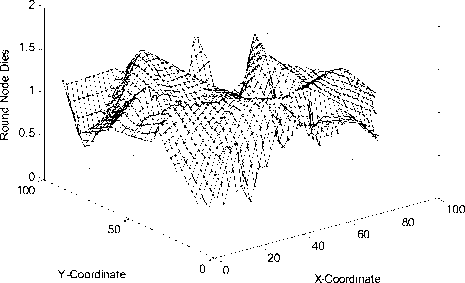
(f)
Figure 3. Comparison between SEP and D-SEP in presence of heterogenity:
(a) Alive nodes per round
(b) Total data packects transmistted to BS over rounds
(c) Nodes dead per round
(d) Total energy consumed per round
(e) Node dying distribution for SEP
(f) Node dying distribution for D-SEP
Here in Fig. 3 we have investigated the number of nodes that are alive or dead during the lifetime of the network. Stability period and lifetime of D-SEP is longer as compared to SEP. In Fig 3(a) for SEP protocol the death of nodes starts after 1000 rounds and last node dies after 3800 rounds, whereas in case of D-SEP death of first node starts after 2000 rounds and last node after 16000 rounds . So, considering the death of last node in the network our investigation shows that there is 4.21 times improvement in case of D-SEP.
Case-2: (m = 0.3, m o = 0.6, a = 1 and b = 1.5)
In this case there are 12 advanced nodes deployed with 2 times more energy than normal nodes and 18
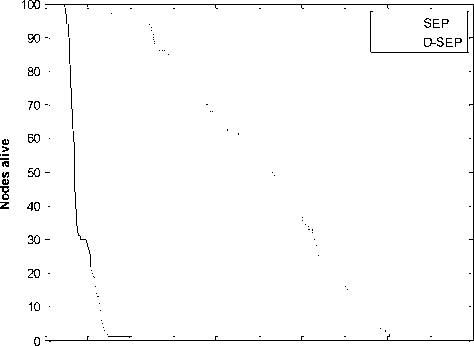
0 0.2 0.4 0.6 0.8 1 1.2 1.4 1.6 1.8 2
No. of rounds 4
(a)
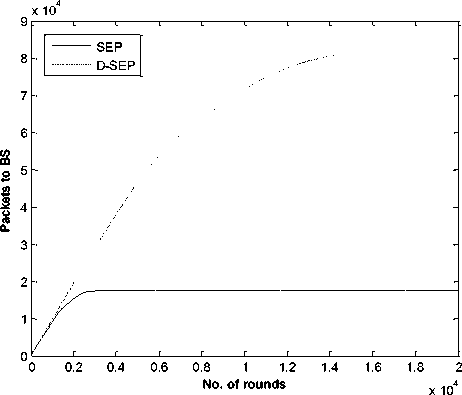
D-SEP

SEP
D-SEP
0 0.2 0.4

0.6 0.8 1 1.2 1.4 1.6 1.8 2
No. of rounds 4
(c)
4 x 104
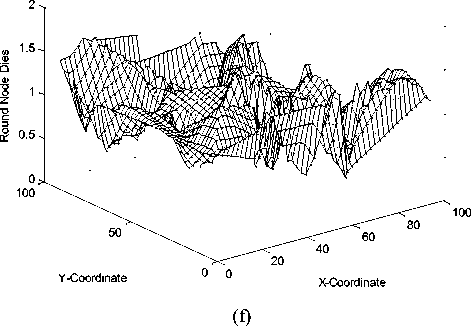
Figure 4. Comparison between SEP and D-SEP in presence of heterogenity:
(a) Alive nodes per round
(b) Total data packects transmistted to BS over rounds
(c) Nodes dead per round
(d) Total energy consumed per round
(e) Node dying distribution for SEP
(f) Node dying distribution for D-SEP
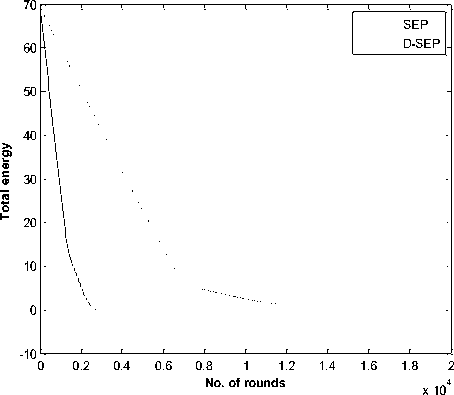
(d)
SEP
Round Node Dies
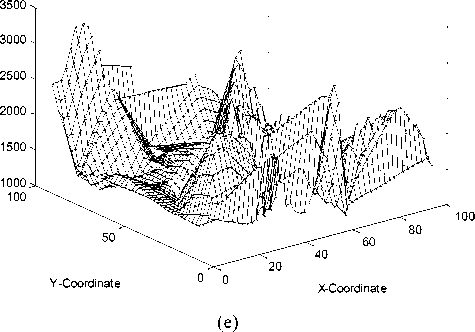
Case-3: (m = 0.5, mo = 0.4, a = 0.75 and b = 1.5)
In this case, we have deployed 30 advanced nodes with 1.75 times more energy than normal nodes and 20 super nodes deployed with 2.5 times more energy than the normal nodes. The investigations clearly show that by introducing super nodes network lifetime increases. In Fig. 5(a), the SEP protocol indicate the death of nodes starts after 1000 rounds, while in case of D-SEP it starts after 5000 rounds. In SEP last node dies after 6500 rounds, while it is more than 26000 rounds in case of D-SEP. The results ascertain that there is increase of 4 times in the lifetime of network in case of D-SEP over SEP.
Fig. 5(b), shows the comparison in terms of number of data packets transmitted to the BS. Here, we have observed that in case of SEP the network is able to transmit total 22000 packets to BS, while in case of D-SEP this transmission is 125000 packets during the lifetime of the network. Here, for D-SEP, we have
noticed 5.68 times higher data transmission to BS over SEP protocol. In Fig. 5(c) it has been observed that the lifetime of networks is up to 6500 and 26000 rounds in case of SEP and D-SEP respectively. Here, the results predict that there is 4 times improvement in case of D-SEP. The total energy over the time has been indicated in Fig. 5(d).
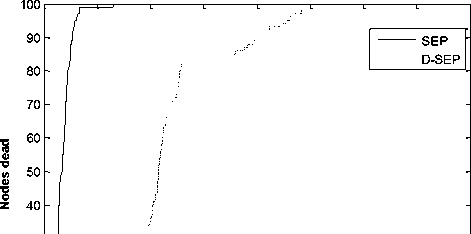
0U---------------------г------------с------------с------------г------------г------------г1
0 0.5 1 1.5 2 2.5 3 3.54
No. of rounds
■О о
Z 40

0 0.5 1 1.5 2 2.5 3 3.5 4
No. of rounds 4
(c)
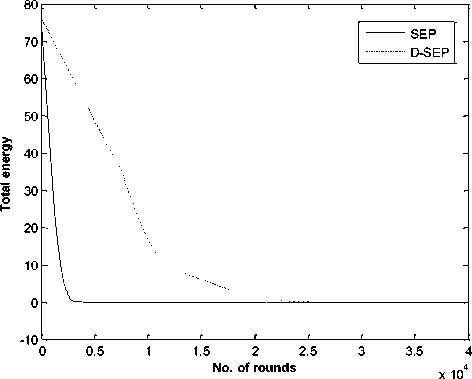
(a)
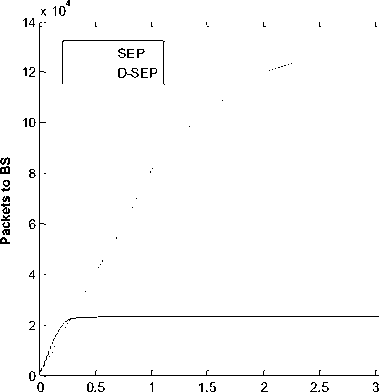
No. of rounds
(b)
SEP
x 104
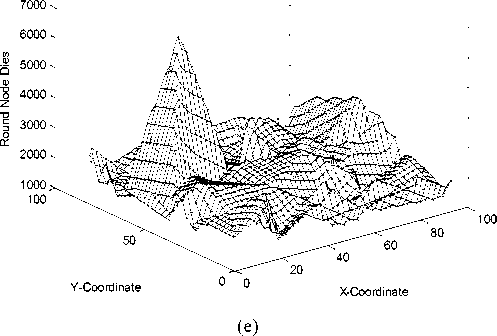
D-SEP
x 104
Round Node Dies
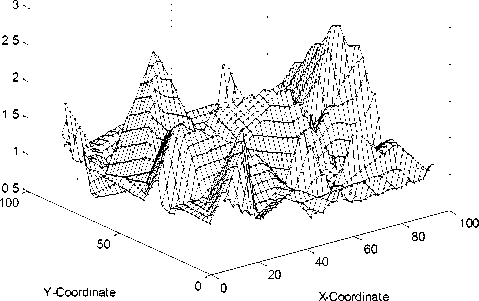
(f)
Figure 5. Comparison between SEP and D-SEP in presence of heterogenity:
(a) Alive nodes per round
(b) Total data packects transmistted to BS over rounds
(c) Nodes dead per round
(d) Total energy consumed per round
(e) Node dying distribution for SEP
(f) Node dying distribution for D-SEP
Case-4: (m = 0.5, mo = 0.4, a = 1.5 and b = 3)
In this case, there are 30 advanced nodes deployed with 2.5 times more energy than normal nodes and 20 super nodes deployed with 4 times more energy than the normal nodes. The investigation clearly shows that by introducing super nodes network lifetime increases. In Fig. 6(a) for SEP protocol the death of nodes starts after 1500 rounds, while in case of D-SEP it is after 6000 rounds. The last node dies after 9000 and 29000 rounds for SEP and D-SEP respectively. The enhancement of 3.22 fold is noticed in case of D-SEP over SEP. Fig. 6(b) depicts the comparison of packet delivery to BS with respect to number of rounds for SEP and D-SEP. The results clearly envisage that higher numbers of data packets are transmitted to the BS in case of D-SEP in comparison to the SEP. In case of D-SEP 125000 packets are send to the BS, whereas these are 30000 in case of SEP. The investigations prove that packets delivery to BS is increased by 4.16 fold in case of D-SEP over SEP protocol. In Fig. 6(c) shows that the death of first sensor node start after 1500 and 6000 rounds in case of SEP and D-SEP respectively. The stability of sensor network is up to 9000 and 29000 rounds in case of SEP and D-SEP respectively.
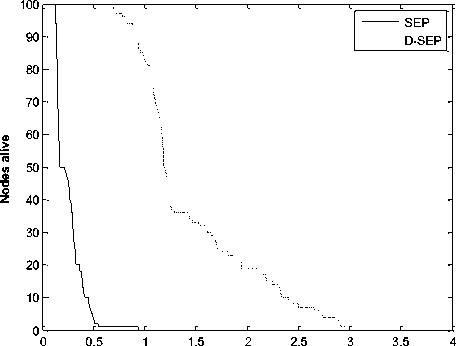
No. of rounds
4 x 104
(a)
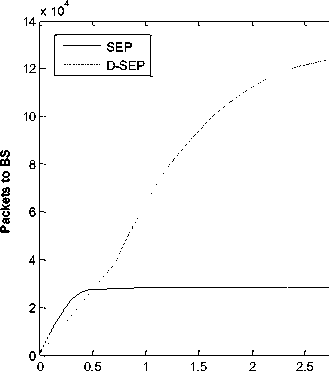
No. of rounds
(b)
3.5 4
x 104
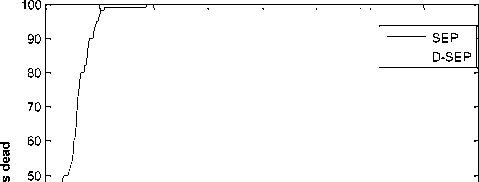
Z 40
0 U :£---------£---------£---------£---------£---------£1
0 0.5 1 1.5 2 2.5 3 3.54
No. of rounds
(c)
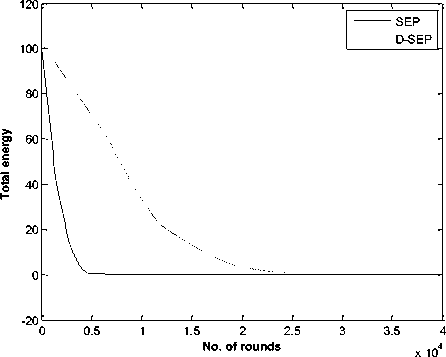
(d)
SEP
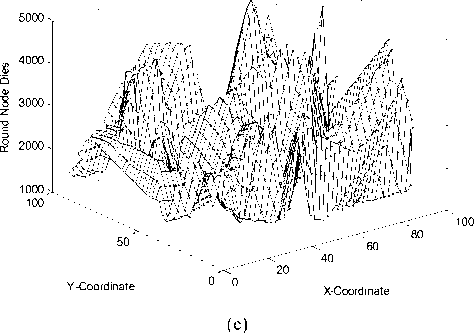
D-SEP
x 104
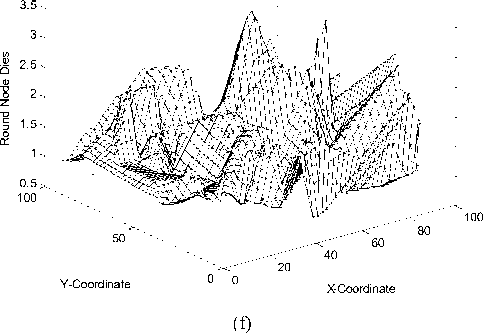
Figure 6. Comparison between SEP and D-SEP in presence of heterogenity:
(a) Alive nodes per round
(b) Total data packects transmistted to BS over rounds
(c) Nodes dead per round
(d) Total energy consumed per round
(e) Node dying distribution for SEP
(f) Node dying distribution for D-SEP
For three-level heterogeneity of WSN, we have considered the four cases and increased the fraction m for super and advanced nodes from 0.3 to 0.5, m0 from 0.4 to 0.6, a from 0.5 to 1.5 and b from 1 to 3. The results obtained from all the four cases envisage that there is significant improvement in the network lifetime, packet delivery, stability and remaining energy of the network. Comparing the four cases of three-level heterogeneous network reported above, it has been noticed that there is 81.25%, 70.58% and 11.53% improvement in the overall lifetime of network in case-4 over the other case-1, case-2 and case-3 respectively.
Multilevel Heterogeneity (0.5, 3)
In the case of multi-level heterogeneity all the nodes have different initial energy within the close set of [0.5, 3]. Here, the total initial energy is considered to be high as compared to other cases reported above. In all cases of D-SEP improves the network lifetime as compared to SEP. Here, the results in Fig. 7(a) for the multi-level heterogeneity, investigations reveal that first node die after 1800 and 5000 rounds for SEP and D-SEP respectively, whereas the death of last node occurs after 5000 and 89000 rounds in case of SEP and D-SEP respectively. There is significant improvement in the network lifetime by using D-SEP protocol over SEP and 17.8 fold improvement has been noticed in case of D-SEP by using the multi-level heterogeneity.
Fig. 7(b) shows the comparison in terms of number of data packets received at the BS. In case of D-SEP 185000 packets are transmitted to BS, which clearly shows that there is 4.63 times improvement in the packet transmission over SEP protocol. In Fig. 7(c) it has been shown that for SEP protocol the death of nodes start after 1800 rounds and death of all nodes is reported after 5000 rounds. However in case of D-SEP protocol the death of nodes starts after 5000 rounds and last node die after 89000 rounds. The investigations divulge that there is 17.8 times improvement using D-SEP over SEP in case of multi-level heterogeneity. Fig. 7(d) illustrates the total remaining energy over rounds. The energy consumption per round is less in D-SEP over SEP and its energy depletion slope rate is 0.028 and 0.0015 J/Round for SEP and D-SEP respectively. The significant improvement has been noticed and that is 18.66 times per round in case of D-SEP over SEP.
Nodes dead Packets to BS Nodes alive
100 п—\—и-----^
01i—Г-----L
SEP
D-SEP
No. of rounds 4
(a)
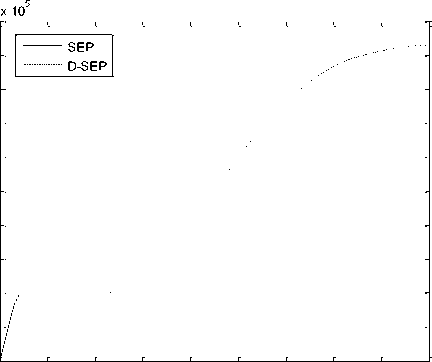
1.8
1.6
1.4
1.2
0.8
0.6
0.4
0.2
No. of rounds 4
(b)
SEP
D-SEP

No. of rounds
(c)
4 x 104
SEP
D-SEP

-20 0
(d)
SEP
4 x 104
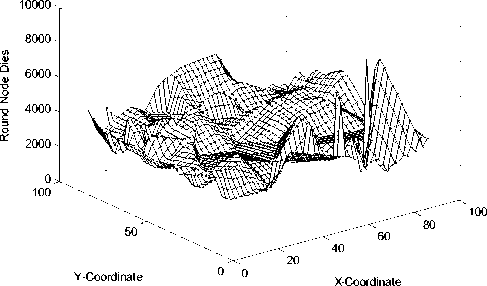
(e)
D-SEP
x 104
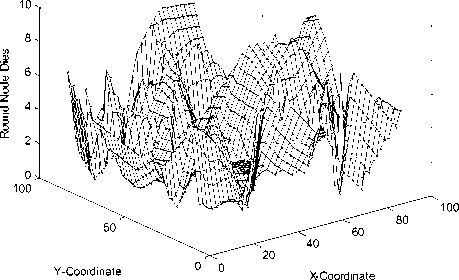
(f)
Figure 7. Comparison between SEP and D-SEP in presence of heterogenity:
-
(a) Alive nodes per round
-
(b) Total data packects transmistted to BS over rounds
-
(c) Nodes dead per round
-
(d) Total energy consumed per round
-
(e) Node dying distribution for SEP
-
(f) Node dying distribution for D-SEP
-
IV. Conclusion
The proposed D-SEP is based on the weighted probabilities as mentioned above to obtain the threshold for normal, super and advanced nodes and that is used to elect the cluster head in each round. Here, two cases for two-level and four cases of three-level heterogeneity have been considered and thereafter results for multilevel heterogeneous network using D-SEP is reported and compared with SEP.
TABLE 2. PERFORMANCE IMPROVEMENT IN CASE OF D-SEP OVER SEP
|
Heterogeneity Level |
Two-Level |
||||
|
Cases |
Case 1 (m = 0.1, a = 0.5) |
Case 2 (m = 0.3, a = 1.5) |
|||
|
Maximum Number of Rounds |
11000 |
21000 |
|||
|
Nodes Alive |
Improvement over SEP (times) |
4.4 |
4.11 |
||
|
No. of Data Packets |
Improvement over SEP (times) |
13.18 |
7.38 |
||
|
Total Remaining Energy |
Improvement over SEP (times) |
4.42 |
4.11 |
||
|
Heterogeneity Level |
Three-Level |
||||
|
Cases |
Case 1 (m = 0.3, m 0 = 0.6, a = 0.5, b = 1) |
Case 2 (m = 0.3, m 0 = 0.6, a = 1, b = 1.5) |
Case 3 (m = 0.5, m 0 = 0.4, a = 0.75, b = 1.5) |
Case 4 (m = 0.5, m 0 = 0.4, a = 1.5, b = 3) |
|
|
Maximum Number of Rounds |
16000 |
17000 |
26000 |
29000 |
|
|
Nodes Alive |
Improvement over SEP (times) |
4.21 |
4.25 |
4 |
3.22 |
|
No. of Data Packets |
Improvement over SEP (times) |
6 |
4.55 |
5.68 |
4.16 |
|
Total Remaining Energy |
Improvement over SEP (times) Per Round |
4.21 |
4.27 |
4.12 |
4.86 |
|
Heterogeneity Level |
Multi-level (within the close set of 0.5, 3) |
||||
|
Maximum Number of Rounds |
89000 |
||||
|
Nodes Alive |
Improvement over SEP (times) |
17.8 |
|||
|
No. of Data Packets |
Improvement over SEP (times) |
4.63 |
|||
|
Total Remaining Energy |
Improvement over SEP (times) Per Round |
18.66 |
|||
For two-level heterogeneous network, we have increased the fraction m of the advanced nodes from 0.1 to 0.3 and a from 0.5 to 1.5 that gives significant improvement in the performance of the network in terms of increase in number of rounds that leads to enhance lifetime of the network that is 1.9 times higher in case-2 in comparison with case-1.
For three-level heterogeneity of WSN, we have obtained the results by taking four cases and increased the fraction m for super and advanced nodes from 0.3 to 0.5, m0 from 0.4 to 0.6, a from 0.5 to 1.5 and b from 1 to 3. The results acquired from all the four cases predict that there is considerable improvement in the lifetime, packet delivery, stability and remaining energy of the network. The comparison of four cases of three-level heterogeneous witnessed that there is 81.25%, 70.58% and 11.53% enhancement in the overall lifetime of network for the case-4 over case-1, case-2 and case-3 respectively. In the case of multi-level heterogeneity, there is improvement of 17.8 fold in the lifetime of the network by using D-SEP comparing to SEP protocol. Moreover the energy depletion slope rate per round is much low in case of D-SEP over SEP. So we can conclude that more the energy level of the network more stable it is and more is the lifetime.
Список литературы Proficient D-SEP Protocol with Heterogeneity for Maximizing the Lifetime of Wireless Sensor Networks
- W. R. Heinzelman, A. Chandrakasan, and H. Balakrishnan. "Energy-efficient communication protocol for wireless microsensor networks", Proceedings of the 33rd Hawaii International Conference on System Sciences (HICSS-33), (2000), pp. .
- S. Lindsey, C.S. Raghavenda, "PEGASIS: power efficient gathering in sensor information systems", Proceeding of the IEEE Aerospace Conference, Big Sky, Montana, (2002).
- O. Younis, S. Fahmy, "HEED: A hybrid, energyefficient, distributed clustering approach for ad hoc sensor networks", IEEE Transactions on Mobile Computing vol 3, no 4, (2004), pp. 660-669.
- W.R. Heinzelman, A.P. Chandrakasan, H. Balakrishnan, "An application- specific protocol architecture for wireless microsensor networks", IEEE Transactions on Wireless Communications vol 1, no 4, (2002), pp 660-670.
- G. Smaragdakis, I. Matta, A. Bestavros, "SEP: A Stable Election Protocol for clustered heterogeneous wireless sensor networks", Second International Workshop on Sensor and Actor Network Protocols and Applications (SANPA 2004), (2004).
- V. Mhatre, C. Rosenberg, "Design guidelines for wireless sensor networks: communication, clustering and aggregation," Ad Hoc Network Journal, vol 2, no 1, (2004), pp 45-63.
- M. Ye, C. Li, G. Chen, J. Wu, "EECS: an energy efficient cluster scheme in wireless sensor networks", IEEE International Workshop on Strategies for Energy Efficiency in Ad Hoc and Sensor Networks IEEE IWSEEASN 2005, Phoenix, Arizona, (2005).
- A. Depedri, A. Zanella, R. Verdone, "An energy efficient protocol for wireless sensor networks", Autonomous Intelligent Networks and Systems (AINS 2003), Menlo Park, CA, (2003).
- Q. Li, Z. Qingxinand W. Mingwen, "Design of a distributed energy efficient clustering algorithm for heterogeneous wireless sensor networks," Computer Communications, vol. 29, (2006), pp. 2230-7, 2006.
- B. Elbhiri, R. Saadane, D. Aboutajdine, “Stochastic and Equitable Distributed Energy-Efficient Clustering (SEDEEC) for heterogeneous wireless sensor networks” International Journal of Ad Hoc and Ubiquitous Computing, Inder Science Publishers, UK, Vol. 7, No.1 (2011), pp. 4–11.
- E. Brahim, S. Rachid, A. Zamora and D. Aboutajdine, “Stochastic and Balanced Distributed Energy-Efficient Clustering (SBDEEC) for Heterogeneous Wireless Sensor Networks”, Vol. 8, No. 3, (2009), pp.11-20.
- R. B. Patel, T. S. Aseri, Dilip Kumar, “EEHC: Energy efficient heterogeneous clustered scheme for wireless sensor networks”, International Journal of Computer Communications, Elsevier, (2009), 32(4), pp. 662-667.
- Y. Mao, Z. Liu, L. Zhang, X. Li, An Effective Data Gathering Scheme in Heterogeneous Energy Wireless Sensor Networks, Proceedings of International Conference on Computational Science and Engineering, (2009), pp. 338-343.
- Parul Saini and Ajay K Sharma, “Energy Efficient Scheme for Clustering Protocol Prolonging the Lifetime of Heterogeneous Wireless Sensor Networks”, International Journal of Computer Applications (0975 – 8887) Volume 6– No.2, (2010), pp. 31-36.
- E. Brahim, S. Rachid, A. Zamora and D. Aboutajdine, “Developed Distributed Energy-Efficient Clustering (DDEEC) for heterogeneous wireless sensor networks”, IEEE, ISVC 2010 : 5th International Symposium On I/V Communications and Mobile Network, Quartier Hay Ryad, Rabat, Morocco, (2010).

